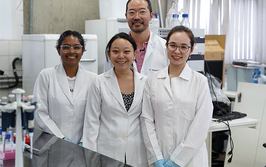The Isotopic Doctor
High-precision isotopic analysis of essential metals is beginning to show real promise for medical diagnoses. Here, I share some of the progress in this exciting application area.
Frank Vanhaecke |
The lightest elements vary in their isotopic composition due to isotope fractionation; this is something we’ve known for quite a while. It occurs when the isotopes of an element do not take part with exactly the same efficiency in a physical process or (bio)chemical reaction. Differences in reaction rates (kinetics) and in equilibrium (thermodynamics), therefore, occur – for example, the lighter of two isotopes will react more quickly, while the heavier will prefer the strongest bonding environment.
In ‘traditional’ isotope systems (hydrogen, nitrogen, carbon, oxygen and sulfur), variations can be studied using gas source isotope ratio mass spectrometry (IRMS). But for heavier elements, the relative difference in mass between the isotopes was initially thought too to be small to result in a measurable variation in the isotopic composition. However, with the advent of improved instrumentation – especially that of multi-collector inductively coupled plasma-mass spectrometry (MC-ICP-MS) in the early 1990s – it is now generally accepted that all elements with two or more isotopes show natural variation in their isotopic composition because of isotope fractionation effects.
Before the introduction of MC-ICP-MS, only thermal ionization mass spectrometry (TIMS) provided sufficient precision for studying natural variation in the isotopic composition of heavier elements. However, its widespread use was hampered because of low sample throughput capability and the limited ionization power of its source (only elements with an ionization energy up to 7 eV are efficiently converted into M+ ions). With the ICP providing a much more powerful ionization source at atmospheric pressure, MC-ICP-MS can analyze a broader range of target elements. Indeed, geochemists welcomed MC-ICP-MS with open arms for studying non-traditional isotope systems in various application areas.
Today, a few institutions around the world are using MC-ICP-MS for high-precision isotopic analysis of metals in body fluids as a potential new tool for medical diagnosis. In a NASA-funded study, a research group at Arizona State University, USA, discovered that natural changes in the isotopic composition of calcium in urine indicate bone loss in bed rest patients. In follow-up work, they demonstrated that the approach could also signal multiple myeloma disease activity. In a pilot study, researchers at the École Normale Supérieure de Lyon, France, showed that the isotopic composition of serum copper in breast and colorectal cancer patients reflected response to chemotherapeutic treatment more quickly than traditional biomarkers.
Ghent University, Belgium, is among these pioneering institutions. In the work performed so far, we have shown that Wilson’s disease, a hereditary illness that interferes with the excretion of excess copper into the bile, leads to a significantly lighter isotopic composition of serum copper. In liver cirrhosis sufferers, we have revealed that the isotopic composition of serum copper reflects the severity of the disease. This breakthrough is potentially useful for prioritizing liver transplant patients.
Another promising application is isotopic analysis of whole blood/serum iron, as pioneered by researchers at ETH-Zürich, Switzerland. The serum concentration of ferritin is the clinically most useful measure of iron storage. Low serum ferritin levels indicate depleted iron, whereas increased levels may indicate overload. Inflammatory conditions (or infections, cancer and liver disorders) will also influence ferritin concentration; as a result, a large number of patients remain at risk from iron depletion or overload. We have seen a link between iron status and the isotopic composition of whole blood iron. This is a potentially better marker for iron status and it has the benefit of offering access to both short term (via serum iron) and longer term (via red blood cells or whole blood iron) information.
Despite the relatively high cost of an MC-ICP-MS analysis, the medical world is interested in the approach for earlier and non-invasive diagnosis and prognosis of diseases. Are we there yet? Not exactly. Several issues, such as the specificity and reproducibility of the shift in the isotopic signature of the target element(s), need assessing, and we need a more thorough understanding of the underlying causes of the changes we observe in isotopic composition. However, we are working on this, experimenting in vitro and in vivo to gain greater insights.
In a biomedical context, the isotopic analysis of non-traditional isotope systems is, therefore, intriguing, particularly as it shows real potential for clinical practice. I am glad that my research group and I – and our colleagues from the Ghent University Hospital – can contribute to progress in this exciting area.
Today, a few institutions around the world are using MC-ICP-MS for high-precision isotopic analysis of metals in body fluids as a potential new tool for medical diagnosis. In a NASA-funded study, a research group at Arizona State University, USA, discovered that natural changes in the isotopic composition of calcium in urine indicate bone loss in bed rest patients. In follow-up work, they demonstrated that the approach could also signal multiple myeloma disease activity. In a pilot study, researchers at the École Normale Supérieure de Lyon, France, showed that the isotopic composition of serum copper in breast and colorectal cancer patients reflected response to chemotherapeutic treatment more quickly than traditional biomarkers.
Ghent University, Belgium, is among these pioneering institutions. In the work performed so far, we have shown that Wilson’s disease, a hereditary illness that interferes with the excretion of excess copper into the bile, leads to a significantly lighter isotopic composition of serum copper. In liver cirrhosis sufferers, we have revealed that the isotopic composition of serum copper reflects the severity of the disease. This breakthrough is potentially useful for prioritizing liver transplant patients.
Another promising application is isotopic analysis of whole blood/serum iron, as pioneered by researchers at ETH-Zürich, Switzerland. The serum concentration of ferritin is the clinically most useful measure of iron storage. Low serum ferritin levels indicate depleted iron, whereas increased levels may indicate overload. Inflammatory conditions (or infections, cancer and liver disorders) will also influence ferritin concentration; as a result, a large number of patients remain at risk from iron depletion or overload. We have seen a link between iron status and the isotopic composition of whole blood iron. This is a potentially better marker for iron status and it has the benefit of offering access to both short term (via serum iron) and longer term (via red blood cells or whole blood iron) information.
Despite the relatively high cost of an MC-ICP-MS analysis, the medical world is interested in the approach for earlier and non-invasive diagnosis and prognosis of diseases. Are we there yet? Not exactly. Several issues, such as the specificity and reproducibility of the shift in the isotopic signature of the target element(s), need assessing, and we need a more thorough understanding of the underlying causes of the changes we observe in isotopic composition. However, we are working on this, experimenting in vitro and in vivo to gain greater insights.
In a biomedical context, the isotopic analysis of non-traditional isotope systems is, therefore, intriguing, particularly as it shows real potential for clinical practice. I am glad that my research group and I – and our colleagues from the Ghent University Hospital – can contribute to progress in this exciting area.

Frank is Senior Full Professor in Analytical Chemistry at Ghent University (Belgium), where he leads the Atomic & Mass Spectrometry unit, which specializes in the determination, speciation and isotopic analysis of (trace) elements using inductively coupled plasma-mass spectrometry. The group’s interdisciplinary research work brings Frank and his co-workers in contact with a range of fascinating topics, from archaeological glass, meteorite composition, to human health. He and his group’s genuine interest in scientific research motivates him to work enthusiastically (almost) every day, despite the increasing administrative workload. Frank is also editorial board chairperson for the Journal of Analytical Atomic Spectrometry published by the Royal Society of Chemistry.

















